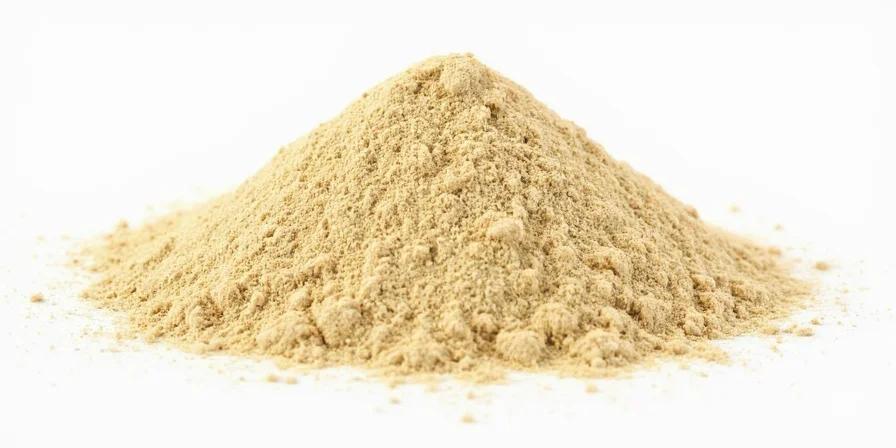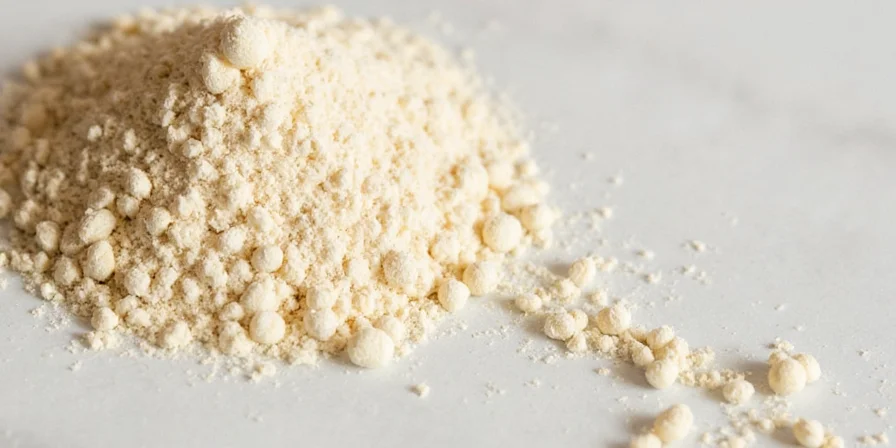Table of Contents
- Introduction
- What Is White Peppercorn Powder? (Simple Definition)
- White Peppercorn Powder Benefits & Uses
- How to Use White Peppercorn Powder: 7 Practical Applications
- White Peppercorn Powder vs Black Pepper: Side-by-Side Comparison
- White Peppercorn Powder Storage Tips: Keep It Fresh Longer
- Why White Pepper Exists: Historical Context
- When to Choose White Peppercorn Powder
What Is White Peppercorn Powder and Why Chefs Prefer It for Certain Dishes
White peppercorn powder is a spice made from fully ripe Piper nigrum berries with the dark outer layer (pericarp) removed through fermentation before drying. Unlike black pepper, it delivers a milder, earthier flavor profile with subtle fermented notes while maintaining visual purity in light-colored dishes. This makes it the preferred choice for cream sauces, mashed potatoes, and delicate French cuisine where black pepper's visible specks would be undesirable.

What Is White Peppercorn Powder? (Simple Definition)
White peppercorn powder comes from ripe peppercorns that have undergone a specific processing method: the red ripe berries are soaked in water for about a week, allowing the outer skin to soften and ferment. After the outer layer is removed, the remaining seed is dried and ground into powder. This process creates a seasoning with 15-20% piperine (the compound responsible for pepper's heat) compared to black pepper's 20-26%, resulting in a more subtle warming sensation.
Unlike common misconceptions, white peppercorn powder isn't just bleached black pepper—it's a distinct product with different chemical composition and culinary applications. Its pale color makes it indispensable in dishes where visual presentation matters as much as flavor.

White Peppercorn Powder Benefits & Culinary Advantages
- Visual Purity: Provides seasoning without black specks, essential for béchamel, velouté, and white wine sauces where appearance matters.
- Subtle Flavor Profile: Offers earthy warmth without the citrus notes of black pepper, making it ideal for delicate seafood and chicken dishes.
- Digestive Benefits: Contains piperine that enhances nutrient absorption, though at lower concentrations than black pepper (studies show 15-20% piperine content vs 20-26% in black pepper).
- Traditional Medicine Value: Used in Traditional Chinese Medicine for warming properties without altering soup coloration in medicinal broths.
- Culinary Precision: Allows chefs to control heat levels more precisely in light-colored dishes where black pepper would overpower visually.

How to Use White Peppercorn Powder: 7 Practical Applications
White peppercorn powder shines in specific culinary scenarios where its unique properties solve common cooking challenges:
- Cream-Based Sauces: Use in béchamel or Alfredo sauces where black pepper specks would be visually distracting (¼ teaspoon per cup of sauce).
- Pureed Vegetables: Season mashed potatoes or cauliflower purée without compromising smooth appearance.
- Light-Colored Soups: Enhance corn chowder or asparagus soup while maintaining visual elegance.
- Poultry Dishes: Create subtle marinades for chicken or turkey that penetrate without competing with herbs.
- Savory Baking: Elevate cheese scones or quiches with earthy notes without visible specks.
- Fish Preparations: Season delicate white fish fillets where black pepper would overpower both visually and flavor-wise.
- Unexpected Pairing: Add ⅛ teaspoon to dark chocolate desserts for intriguing flavor complexity (a technique used in Michelin-starred restaurants).

White Peppercorn Powder vs Black Pepper: Side-by-Side Comparison
Understanding these key differences helps determine which pepper to use for specific culinary applications:
| Characteristic | White Peppercorn Powder | Black Pepper |
|---|---|---|
| Processing Method | Ripe berries fermented, outer hull removed, then dried | Unripe berries sun-dried with hull intact |
| Flavor Profile | Mild, earthy, slightly fermented, subtle warmth | Sharp, citrusy, robust, more pronounced heat |
| Piperine Content | 15-20% (milder heat) | 20-26% (stronger heat) |
| Best Culinary Uses | Cream sauces, light soups, delicate proteins, purees | Steaks, roasted vegetables, bold sauces, hearty stews |
| Visual Impact | No visible specks, maintains uniform color | Creates noticeable black specks |
| Shelf Life (ground) | 6 months before significant potency loss | 6 months before significant potency loss |

White Peppercorn Powder Storage Tips: Keep It Fresh Longer
- Container Choice: Store in opaque, airtight glass containers—light exposure degrades flavor compounds 3x faster than dark storage (research shows ground spices lose 30% potency within 6 months when exposed to light).
- Whole vs. Ground: Keep whole peppercorns and grind as needed—whole peppercorns retain 90% of flavor for 1-2 years versus 6 months for pre-ground powder.
- Moisture Prevention: Add a silica packet to storage container—white pepper's processed nature makes it more susceptible to moisture absorption than black pepper.
- Flavor Pairing Guide: Combines perfectly with nutmeg in béchamel (use ¼ tsp white pepper + ⅛ tsp nutmeg per cup of sauce) or ginger in Asian broths (¼ tsp white pepper per quart of broth).
- Dosage Guidance: Start with ⅛-¼ teaspoon per serving for light dishes; its subtlety requires precise measurement unlike more robust black pepper.

Why White Pepper Exists: Historical Context You Should Know
White pepper's origins trace back to Ming Dynasty China (1368-1644), where culinary aesthetics valued visual purity in medicinal broths and ceremonial dishes. Unlike Europe's preference for black pepper's bold appearance, Chinese chefs needed a seasoning that provided warmth without altering soup coloration—a requirement that made white pepper essential in traditional recipes.
During the 17th century, Dutch traders discovered that removing the pericarp reduced shipping weight by 15%, making white pepper more economical to transport. This commercial advantage, combined with French cuisine's emphasis on visual presentation, established white pepper as the preferred choice for elite European dishes like coq au vin and sauce béchamel. Understanding this historical context explains why classic French recipes specifically call for white pepper—it's not a substitution but a deliberate choice for maintaining sauce elegance while delivering nuanced heat.

When to Choose White Peppercorn Powder: The Chef's Decision Guide
White peppercorn powder isn't merely an alternative to black pepper—it's a strategic culinary tool for specific scenarios. Choose white peppercorn powder when:
- You're preparing light-colored dishes where visual presentation matters (soups, sauces, purees)
- The recipe requires subtle heat without competing citrus notes
- Following traditional French or Chinese recipes that specifically call for it
- You need precise heat control in delicate proteins like fish or chicken
Avoid substituting white for black pepper in bold dishes like steaks, chili, or roasted vegetables where black pepper's characteristic flavor and visual texture enhance the dish. Remember: white peppercorn powder's value lies in its ability to deliver seasoning without visual distraction—a precision tool that solves specific culinary challenges. Next time you're seasoning a light-colored dish, ask yourself: does this recipe need bold declaration or refined enhancement?

Frequently Asked Questions
Can white peppercorn powder replace black pepper in all recipes?
No. Use white peppercorn powder only in light-colored dishes where black pepper's specks would be undesirable (cream sauces, mashed potatoes, white wine sauces). For bold-flavored dishes like steaks, chili, or roasted vegetables, black pepper provides necessary complexity and visual texture that white pepper lacks.
Why does my white pepper sometimes taste musty?
This indicates improper fermentation during processing or moisture exposure after purchase. High-quality white peppercorn powder should have a clean, earthy aroma. Prevent mustiness by storing in an opaque, airtight container with a silica packet in a cool, dark place—moisture absorption significantly amplifies off-flavors in white pepper compared to black.
Is white peppercorn powder less healthy than black pepper?
It contains slightly less piperine (15-20% vs black pepper's 20-26%), but still offers significant digestive benefits and nutrient absorption enhancement. The health impact difference is negligible for typical culinary use—both provide comparable benefits when used appropriately for their intended culinary applications.
How much white peppercorn powder equals one black peppercorn?
Due to its milder heat, you'll need approximately 25% more white peppercorn powder to match the heat level of black pepper. For precise substitution: ¼ teaspoon white peppercorn powder ≈ 3/16 teaspoon black pepper. Always adjust to taste, as heat perception varies between individuals.











 浙公网安备
33010002000092号
浙公网安备
33010002000092号 浙B2-20120091-4
浙B2-20120091-4